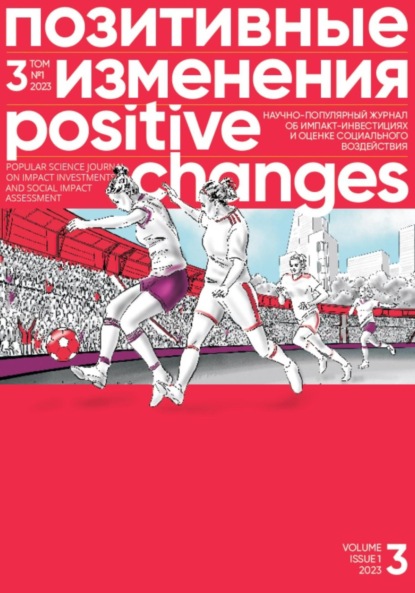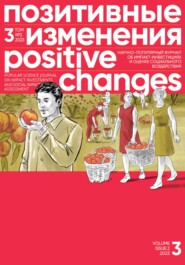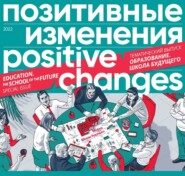По всем вопросам обращайтесь на: info@litportal.ru
(©) 2003-2024.
✖
Позитивные изменения, Том 3 №1, 2023. Positive changes. Volume 3, Issue 1 (2023)
Настройки чтения
Размер шрифта
Высота строк
Поля
This exercise helps social investors understand that they value different financial instruments differently. They look at different types of stocks, investment funds or bonds using different criteria, and we also evaluate different programs using different criteria depending on the nature of the program and the nature of the investment. Using the logic of evaluating financial instruments helps them understand the logic of evaluating programs.
The theory of transformation, trying to change systems, must consist of many different theories of change. The Blue Marble evaluation is related to the theory of transformation: once we start dealing with large systems, we are dealing with global impacts.
Investors in social projects also have internal networks and have developed a number of methodological approaches. For example, they are very fond of the social return on investment (SROI) method. Sometimes it is even taken as the only possible, no-alternative method for evaluating the results of any project. This seems to go at odds with the evaluation specialists’ views – again, based on the utilization-focused evaluation concept.
The social effectiveness of investments still needs to be interpreted and adapted, depending on whether we are talking about long-term or short-term social effectiveness of investments, about innovative high-risk programs, high-risk programs with high performance potential, or low-risk, low-return programs. When I talk about parallels between different kinds of financial instruments and different kinds of programs, I’m talking about how much risk social project investors are willing to take, how innovative they want to be, what the time span is for investment and return, whether they are looking for several different indicators or just one measure of success.
There is a lot to negotiate and a lot to adapt, even with the general criteria of investing in social projects. It is also necessary to determine what it means to invest in social projects and the effectiveness of such investments in a particular situation. And this is where utilization-focused evaluation is needed, because it provides a dialogue with clients and helps them articulate the timing, the criteria, the degree of risk they are willing to accept, and the required level of return on investment.
Using the logic of evaluating financial instruments helps social investors understand the logic of evaluating programs.
The next question concerns the theory of transformation. What is the difference between your proposed term “theory of transformation” and theory of change?
That’s a great question! Theory of change was a concept suggested in 1995 by sociologist Carol Weiss, who observed how foundations began to implement programs without knowing what data on effectiveness the studies showed. They didn’t know about advances in social sciences, about how to fight poverty or drug addiction.
Now we have moved on to trying to change entire systems (climate, agriculture, food, healthcare). When you start changing the system, you go beyond one particular project.
The theory of change looks at an individual project or program, while the theory of transformation, trying to change systems, must consist of many different theories of change. For example, the anti-smoking campaign has more than one theory of change. You need to educate people about the dangers of smoking, work with advertising and marketing, with healthcare. You need regulations and incentives, active work with tobacco manufacturers, with young people, with the elderly.
There are many different approaches to fighting smoking, each with their own theory of change, and the theory of transformation attempts to integrate all of these different theories of change to achieve an overall systemic impact.
I think this also applies to the Blue Marble concept[8 - The Blue Marble is a photograph of Planet Earth taken on December 7, 1972 by the crew of Apollo 17 spacecraft from a distance of around 29,000 kilometers from the planet’s surface. For the astronauts, Earth was the size and appearance of a blue marble (a colored glass ball toy).]that you’re working on right now. Could you briefly describe the main ideas of this concept?1
The Blue Marble evaluation is related to the theory of transformation: once we start dealing with large systems, we are dealing with global impacts. For example, the state of agriculture in any country is affected by climate change, world markets, government policies, the policies of international agencies, trade, and transportation. The idea behind the Blue Marble evaluation is that we need to understand not only what is happening in a particular local program, but also how that program is affected by global and international trends, such as pandemics or climate change.
The Blue Marble evaluation concept connects the local with the global. The English word for this is “glocal,” which is a portmanteau of “local” and “global.” It means looking for interactions and interconnections between the local and the global, so that our understanding at the global level is based on an understanding of local processes, and our understanding of what is happening at the local level is conditioned by an understanding of global trends.
Let’s talk about the implementation of this concept in the evaluators’ practical work. For example, if an evaluator decides to use the Blue Marble concept in his work, where should they begin?
Let’s take investing in social projects as an example again. For any social project investment, it is important to consider the specific project towards which the funds will be invested, but from the Blue Marble perspective, evaluators also need to know what other social project investors are doing. What is happening in other countries? What are the global trends in social project investment? What networks are involved? The more money goes into social projects on a global level, the more important it is to apply global trends and patterns to each specific project.
The work of the evaluator in this case includes not only developing a specific social impact evaluation, but also knowing the global context, what is going on in other social impact evaluation projects, what can be learned from them, what the indicators are, and how this relates to the sustainable development goals. For example, is a particular social project investment linked to one sustainability goal or several sustainability goals? Specifically, this means that the evaluator needs to learn how to place the individual project in a broader global context.
Do you have a manual or a list of questions that the evaluator should ask? Like not forgetting climate change and other global issues, for example.
Yes, I do have such a list of questions. As you suggested, the first part relates to climate – how does the project relate to sustainable development, recovery, climate change mitigation? The thing is that we are living in a climate emergency, and any action we take can have an impact on it.
Another set of questions concerns social justice, because the gap between rich people and poor people, between richer and poorer countries, keeps growing endlessly. There is an ethical criterion for how a particular project supports gender, social and economic equality and racial justice. Thus, social justice and equity issues and climate change impacts have become universal aspects to be considered in all program evaluations.
My final question is about the future. If we try to look into the near future of program evaluation, what changes can we expect?
I think there will be more networks of evaluators exchanging data and communicating with each other, because we are dealing with systemic change. For example, I work with the Global Alliance for the Future of Food, which combines 30 charities on four continents. This includes foundations from North America, Europe, South America and Asia.
Solving global problems and tracking systemic change requires a collaborative team of evaluators from different countries, speaking different languages and with different methodological skills. Last year, me and a team of Blue Marble evaluators participated in the evaluation of the UN Food Systems Summit.
Currently I am working with the new International Evaluation Academy, which has participants from all over the world. I am part of the Russian Association of Specialists in Program and Policy Evaluation, and I’m assisting the International Organization for Cooperation and Evaluation. International and global networks and evaluation teams are definitely part of our future.
Экспертные мнения / Expert Opinions
Без стандартов, но по призванию. Является ли оценка проектов и программ профессией?
Тема профессионализации оценки проектов и программ (в социальной сфере, культуре, науки, экологии и т. д.) существует в повестке международных организаций второй десяток лет, в российской практике – около десяти. Появляется много публикаций, проводятся дискуссии, специалисты по оценке обсуждают статус ее как профессии на региональном и международном уровне. В нашей стране эта тема рассматривается на ежегодных конференциях Ассоциации специалистов по оценке программ и политик (АСОПП). Так является ли оценка проектов и программ профессией, и если да, то как это можно понять и узнать?
Юлия Вяткина
Редактор журнала «Позитивные изменения»
СТАДИИ ПРЕВРАЩЕНИЯ ЗАНЯТИЯ В ПРОФЕССИЮ
Прежде чем начать разговор о профессионализации оценки (здесь и далее под оценкой мы будем понимать оценку проектов и программ – прим. ред), рассмотрим, каким образом то или иное занятие превращается в профессию.
Американский социолог Гарольд Виленски, исследовавший функционирование различных организационных структур в современном обществе, предложил в 60-х гг. прошлого века модель, согласно которой формирование профессии проходит несколько стадий[9 - Wilensky, L. (1964). The professionalization of everyone? American Journal of Sociology, 70(2), 137–158. Ayoo, S., Wilcox, Y., LaVelle, J. M., Podems, D., & Barrington, G. V. (2020). Grounding the 2018 AEA Evaluator Competencies in the broader context of professionalization. In J. A King (Ed.), The American Evaluation Association’s Program Evaluator Competencies. New Directions for Evaluation, 2020, 13 30.].
Все начинается с того, что некое занятие приобретает статус полной занятости. Т. е. достаточно много людей занимаются некой деятельностью с утра до вечера и зарабатывают этим на жизнь. Полная занятость – это отправная точка, иначе занятие не может превратиться в профессию. Кроме того, она возможна, когда есть спрос на услуги.
Вторая стадия – это появление школы профессиональной подготовки людей, которые занимаются этим видом деятельности. Такая школа чаще всего ассоциирована с университетами. Далее появляется профессиональная ассоциация – объединение людей, которые занимаются этой деятельностью на постоянной основе. Ассоциация делает определенные шаги, чтобы со стороны государства были приняты какие-то нормативные документы, которые бы позволяли в установленном порядке лицензировать, сертифицировать деятельность, чтобы появилась своего рода профессиональная монополия. Также профессиональная ассоциация влияет на профподготовку специалистов, появляется теория, методы, стратегии деятельности и компетенции специалистов.
Следующий шаг – этический кодекс, который обеспечивает предотвращение злоупотреблений авторитетом и властью. Профессиональные ассоциации демонстрируют общественности, что они контролируют соблюдение этического кодекса и являются саморегулируемыми.
Еще один этап – формирование позитивного имиджа в обществе. Когда имидж есть, можно говорить о том, что появляется профессия.
ЧТО ТАКОЕ ПРОФЕССИЯ?
Есть два подхода к определению профессии. В первом случае ее обозначают как деятельность, занятие, работу. Во втором – как группу людей.
Профессия как деятельность – это оплачиваемая работа, особенно та, которая предполагает длительное обучение и формальную квалификацию. Соответственно, профессионал – это человек, который прошел такое обучение, получил подтверждение своей квалификации и занимается такой работой.
Генеральный директор и старший вице-президент по оценке в Группе Всемирного банка Кэролайн Хайдер выделяет важные черты состоявшихся профессий[10 - Heider, C. Professionalizing Evaluation. 28.04.2015. The World Bank Group. Retrieved from: https://ieg.worldbankgroup.org/blog/professionalizing evaluation. (accessed 01.03.2023).]:
• Существует установленный порядок получения высшего образования, обязательного для каждого члена профессии, а для некоторых профессий требуется регулярное обновление знаний и навыков.
• Профессия требует, чтобы новые выпускники практиковали в тесном сотрудничестве и под наблюдением более опытных практиков.
• Есть сильные, признанные профессиональные ассоциации, которые обеспечивают соблюдение и укрепление стандартов.
• Имеется законодательство, устанавливающее требования и обеспечивающее основу для обращения в суд в случае злоупотребления служебным положением.
ОЦЕНКА – ЭТО ПРОФЕССИЯ?
Мы решили провести собственное небольшое исследование и обратились к экспертам, которые в теме оценки уже достаточно давно. Наши спикеры ответили, что пока еще рано говорить о том, что оценка – это зрелая профессия. Причем степень ее зрелости в разных странах отличается.
«Мне кажется, что эта профессия в стадии становления. Есть много признаков, свидетельствующих об этом. Если взять процент тех, кто закончил высшие учебные заведения по специальности «Оценка», в мире таких специалистов немного. В России пока нет такой специализации. Люди приходят в оценку из разных сфер деятельности с разным бэкграундом», – говорит генеральный директор компании «Процесс Консалтинг» Алексей Кузьмин.
Всегда стоит помнить о том, что когда мы говорим про профессию, то мы должны понимать, что у нее должен быть целый ряд атрибутов. В России часть из них есть, а другой части нет, обращает внимание Ирина Ефремова-Гарт, первый заместитель директора Форума Доноров.
Одним из основных признаков профессионализации той или иной деятельности является самоорганизация сообщества. Например, в нашей стране в 2014 году создана Ассоциация специалистов по оценке программ и политик (АСОПП), миссия которой – развитие и продвижение оценки как профессии в России. Сибирским центром поддержки общественных инициатив и Центром социальных технологий «Гарант» проводятся летние школы по оценке, активно работает клуб PROОЦЕНКУ, на заседаниях которого коллеги обмениваются наработанными практиками и уроками. Не менее важным атрибутом профессионализации является наличие принципов и стандартов, сформулированных сообществом специалистов. В России, как и в других странах, где работают профессиональные ассоциации, такие принципы были разработаны и приняты АСОПП[11 - АСОПП. (2017). Принципы оценки программ и политик АСОПП. Режим доступа: https://www.eval.ru/principles_of_evaluation. (дата доступа: 01.03.2023).]. Их отличительной чертой является то, что каждый из шести принципов содержит рекомендации не только для специалистов по оценке, но и для заказчика, и участника оценки. Еще один признак профессионализации – система сертификации, когда специалист, обладающий опытом и знаниями в сфере оценки, получает официальное подтверждение этому факту. В нашей стране сертификации специалистов по оценке нет, в то же время этого нет во многих странах мира, за исключением Канады и Японии.
В список признаков можно включить и рост интереса вузов к профессиональной подготовке специалистов по оценке: например, в Московском государственном психолого-педагогическом университете появилась магистерская программа «Доказательное проектирование и оценка программ в области управления социальными рисками в сфере детства». Одним из факторов, способствующих развитию оценки в России, стала организация и проведение стратегического аудита со стороны Счетной палаты Российской Федерации. Он проводится в целях оценки реализуемости, рисков и результатов достижения стратегических целей, а также оценки влияния внешних и внутренних факторов на уровень достижения стратегических целей.














